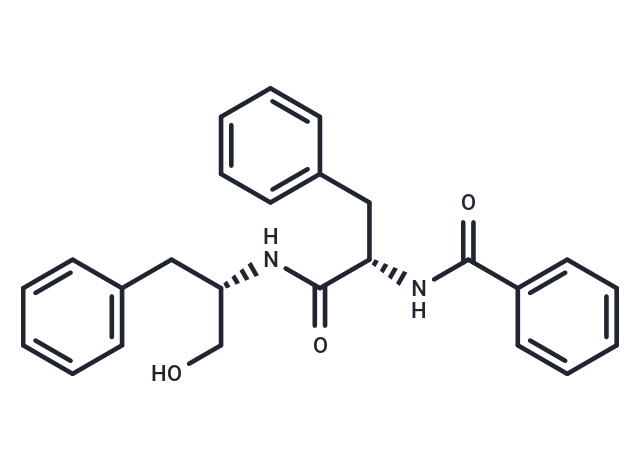Shopping Cart
- Remove All
 Your shopping cart is currently empty
Your shopping cart is currently empty

Aurantiamide has anti-cancer, anti-inflammatory and antinociceptive activities, it may suppress the growth of malignant gliomas by blocking autophagic flux.Aurantiamide has an anti-neuroinflammatory effect on LPS stimulation through its inhibition of the NF-κB, JNK and p38 pathways.

| Pack Size | Price | Availability | Quantity |
|---|---|---|---|
| 1 mg | $139 | In Stock | |
| 5 mg | $347 | In Stock | |
| 10 mg | $515 | In Stock | |
| 25 mg | $823 | In Stock | |
| 50 mg | $1,090 | In Stock | |
| 100 mg | $1,490 | In Stock | |
| 1 mL x 10 mM (in DMSO) | $493 | In Stock |
| Description | Aurantiamide has anti-cancer, anti-inflammatory and antinociceptive activities, it may suppress the growth of malignant gliomas by blocking autophagic flux.Aurantiamide has an anti-neuroinflammatory effect on LPS stimulation through its inhibition of the |
| In vitro | Aurantiamide was shown to block the activation of nuclear factor-kappa B (NF-κB) in lipopolysaccharide (LPS)-induced BV2 microglial cells by inhibiting the phosphorylation of the inhibitor kappa B-α (IκB)-α. Aurantiamide decreased the phosphorylation levels of c-Jun N-terminal kinase (JNK) and p38 mitogen-activated protein kinases (MAPKs).Suggested that aurantiamide has an anti-neuroinflammatory effect on LPS stimulation through its inhibition of the NF-κB, JNK and p38 pathways[1].Aurantiamide has potent anti-viral and anti-inflammatory effects on IAV-infected cells via inhibition of the NF-κB pathway. Therefore ,Aurantiamide could be a potential therapeutic agent for the treatment of influenza[2]. |
| Cell Research | The anti-viral activity of aurantiamide against Influenza A virus (IAV) was determined using the cytopathic effect (CPE) inhibition assay.?Viruses were titrated on Madin-Darby canine kidney (MDCK) cells by plaque assays.?Ribonucleoprotein (RNP) luciferase reporter assay was further conducted to investigate the effect of aurantiamide on the activity of the viral polymerase complex.?HEK293T cells with a stably transfected NF-κB luciferase reporter plasmid were employed to examine the activity of aurantiamide on NF-κB activation.?Activation of the host signaling pathway induced by IAV infection in the absence or presence of aurantiamide was assessed by western blotting.?The effect of aurantiamide on IAV-induced expression of pro-inflammatory cytokines was measured by real-time quantitative PCR and Luminex assays[2]. |
| Alias | TMC-58B |
| Molecular Weight | 402.49 |
| Formula | C25H26N2O3 |
| Cas No. | 58115-31-4 |
| Smiles | OC[C@H](Cc1ccccc1)NC(=O)[C@H](Cc1ccccc1)NC(=O)c1ccccc1 |
| Relative Density. | 1.191 g/cm3 (Predicted) |
| Storage | Powder: -20°C for 3 years | In solvent: -80°C for 1 year | Shipping with blue ice. | |||||||||||||||||||||||||||||||||||
| Solubility Information | DMSO: 50 mg/mL (124.23 mM), Sonication is recommended. | |||||||||||||||||||||||||||||||||||
Solution Preparation Table | ||||||||||||||||||||||||||||||||||||
DMSO
| ||||||||||||||||||||||||||||||||||||

Copyright © 2015-2025 TargetMol Chemicals Inc. All Rights Reserved.